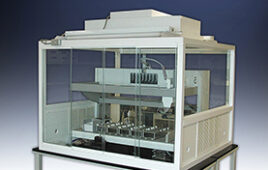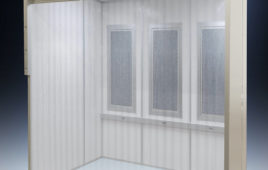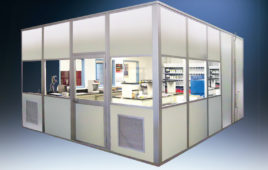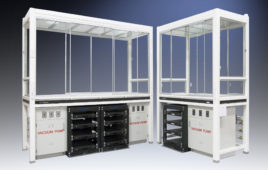Data from particle monitoring in cleanrooms in pharma production applications is critical data. It is crucial that particle monitoring systems are properly supported.
With advances in software and networking, remote assistance and service level agreements (SLA) vendor support contracts should enable pharma production to take full advantage of fast response times over the Internet by a secure remote access point. Coupled with on the shelf critical spares and training production staff and management, pharma companies should be able to consistently manage their monitoring systems to minimize downtime and maximize output and maintain GMP compliance.
PICs GMP Annex 11 Computerized Systems is a GMP standard with guidelines on Risk Mitigation through vendor support applications using SLA’s as well as the validation and operational phases of Computerized Systems such as Environmental Monitoring Systems.
What does PICs GMP Annex 11 say about suppliers and service suppliers? The message is clear: when a third party supplies, installs and services a computerized system such as an environmental monitoring system:
“Formal Agreements must exist between the manufacturer and any third parties and these agreements should include clear statements of the responsibilities of the third party.”
“The competence and reliability of a supplier are key factors when selecting a product or service supplier. The need for an audit should be based on a risk assessment.”
Risk aversion is a major factor in today’s productions industries, not just in pharma—and prudent production and quality managers can see the potential risks and take advantage of vendors’ support when a problem may arise with their systems. By carefully selecting the right supplier or vendor, end users can mitigate against unplanned events.
Pharma companies that are proactive with GMP compliance see the value in SLA services and enable their business continuity to move in the right direction with reduced risks.
During the operational phase, data, data accuracy, data storage, printouts, audit trails, change and configuration management, periodic evaluation, security, incident management, electronic signatures, batch release, archiving and overall business continuity must be addressed. The system supplier normally assists in the validation of the monitoring system. Ongoing support is sometimes overlooked, but it is a critical tool to enabling operations to move forward smoothly.
Monitoring System suppliers should be able to offer services that enable fast and efficient responses in enabling Business Continuity where critical processes. Annex 11 states:
“Provisions should be made to ensure continuity of support for those processes in the event of a system breakdown (e.g. a manual or alternative system). The time required to bring the alternative arrangements into use should be based on risk and appropriate for a particular system and the business process it supports.”
What Should a Service Level Agreement Include?
Did you know that only a small percentage of critical systems are supported by Service Level Agreements for unplanned events. With high risks involved it is crucial that monitoring systems are covered for unplanned events. A good Service Level Agreement should focus on swift resolution of such events that will halt production and risk business continuity.
Service Level Agreement Overview

Recommended technical support to be offered
- Webpage technical support requests—Log onto supplier’s webpage to request support.
- Tracked support case number—Supplier provides a case number and tracks the support provided.
- Guaranteed support timeline—The SLA should state the support times it can provide.
- Remote assistance fast—Technician logs onto the monitoring system remotely.
- Troubleshoot your system—Technician evaluates the problem remotely.
- Diagnose to sensor level—Particle Monitoring system design should allow this ability.
- Plug and play solutions – Using recommended spare parts previously purchased.
- After hours support—Support after normal business hours.
- Weekend support—Support customers who manufacture over weekends.
- Close out reporting—Final report on the support provided and the resolution provided.
- Additional staff training—Review lessons learned. To ensure your team is ready to tackle such future issues promptly and effectively minimize downtime, training is key.
If the remote support cannot resolve the issue, the SLA contract should have a form of escalation. This escalation would enable a technical support engineer to travel to site to fix the problem within the shortest possible timeframe.
Normally with well-trained facilities technical staff and stocked recommended spare parts, most unplanned failures can be resolved without on-site support. It is therefore critical to have your team properly trained and that you have well stocked spares to mitigate against long downtimes. Imagine a critical part of your Particle Monitoring System failing and there is a three- to four-week lead time for that part to become available. How much would the costs be to a manufacturing company in product losses? In many examples those losses are significant. So always look into stocked spare parts and make sure your team is competent in replacement of such spares if the event ever comes up. Would you buy a car without a spare wheel? When it comes to business continuity, a good SLA from your vendor is critical in preventing significant losses in product and profits.
In conjunction with SLAs for unplanned events supported remotely and on-site, it is important that particle counters are calibrated annually or more frequent depending on the level of risk a user is comfortable with and the calibration trending history. With the data from particle counters used to support batch release decisions, it is extremely important that the accuracy of that data is validated.
Vendor evaluation—not only for the type of particle monitoring system software support needed, but also the vendor’s service capabilities regarding the particle counter hardware—is crucial. Your vendor should have a recognized ISO Quality System and calibrations should follow ISO 21501.
ISO 21501 was introduced in 2007, and since then it has become the international standard for particle counter calibrations. Your particle counter supplier should be able to provide ISO 21501 calibrations and the particle counter should be capable of meeting ISO 21501 calibration requirements. Older particle counter models may not meet ISO 21501—since the recent update to ISO 14644-1 actually calls out for particle counters to be calibrated to ISO 21501, there is a risk of not meeting cGMP.
Talk to your supplier if you are not compliant with ISO 21501—they may be able to accommodate you or provide a particle counter that meets compliance.

With SLAs for planned events such as calibration services, it is important to plan ahead and work with your vendor. You never want the instrument to fall out of calibration, as this poses a huge risk and would be a definite nonconformance to cGMP. It is highly recommended to schedule this well in advance so your vendor can support you and have available resources to do so. Most vendors automatically send out recalibration reminders so always follow up or you may regret not doing so.
Remember …. a service-level agreement is a commitment between a service provider and customer. Particular aspects of the service—quality, availability, responsibilities—are agreed upon between the service provider and the service user.
By following the guidelines in PICS GMP Annex 11 you can avert risks with unplanned and planned events. You will be assured that your spare wheel is actually there when you need it and the tire is pumped up. By having a clear business continuity plan, you can mitigate successfully against lost product and expensive lengthy downtimes.
References
- PICs PE 009-14 July 2018 Guide to Good Manufacturing Practice for Medicinal Products Annex 11 Computerized Systems
- ISO 14644-1:2015 Cleanrooms and associated controlled environments—Part 1: Classification of air cleanliness by particle concentration
About the Author
Jason Kelly is Vice President of Services for Lighthouse Worldwide Solutions, headquartered in Fremont, California.




